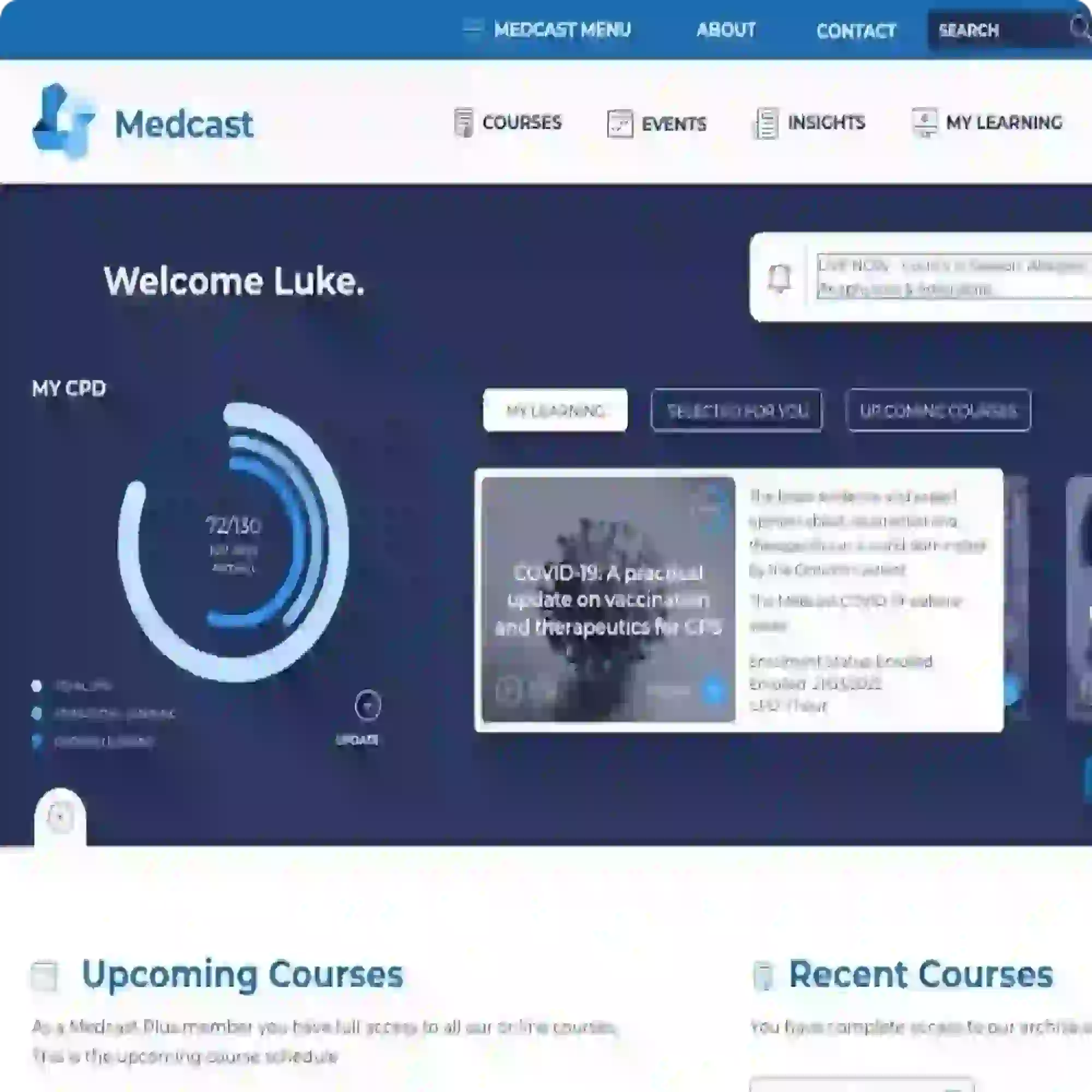Atrial fibrillation diagnosis and assessment - clinical fact sheet & MCQ
![]()
Overview of atrial fibrillation
Atrial fibrillation (AF) is the most common sustained cardiac arrhythmia,1 affecting approximately 5% of individuals over 55 years.2 AF significantly increases the risk of stroke, heart failure, and overall mortality. Individuals who develop AF frequently have coexisting medical conditions and cardiovascular risk factors.
The cornerstones of AF management include addressing comorbidities and precipitating factors, stroke prevention with anticoagulants, and arrhythmia management.1
Many patients with AF are asymptomatic.1 The current recommendation is for opportunistic screening of AF, ie by pulse palpation during a consultation for all patients aged ≥65 years or Aboriginal and Torres Strait Islanders ≥50 years of age.3,4
Diagnosis of atrial fibrillation
Patients commonly present to GPs or to emergency departments with AF. Initial management for many of these patients can be safely done by the GP (eg, those with a controlled ventricular rate and no other significant heart disease).1
A targeted history and physical examination should be performed at the initial assessment and, at regular intervals, the risk of thromboembolism needs to be reviewed, and the need for anticoagulants reassessed for those who have not commenced anticoagulant treatment.5
1. Clinical features5
Patients with AF can be asymptomatic or present with:
- palpitations
- dyspnoea
- fatigue
- dizziness or syncope
- irregular ventricular rate (160-180 beats per minute).
Asymptomatic AF is common and may only be detected during routine examination or investigation for another condition.
Common variants of AF1
- Paroxysmal AF: self-terminating episodes (typically <48 hours, up to 7 days)
- Persistent AF: lasts >7 days, may require intervention for termination
- Permanent AF: AF persists despite attempts to restore a normal rhythm or rhythm control is not used because remaining in atrial fibrillation is accepted by the patient
2. Red flags requiring immediate referral1 (eg, to emergency department):
- haemodynamic instability
- chest pain
- acute heart failure
- syncope or presyncope
- known pre-excitation syndromes (eg, Wolff–Parkinson–White syndrome)
- significant or serious underlying cause suspected (eg, sepsis, surgery).
3. Electrocardiogram (ECG)
Confirmation with an ECG (12-lead, multiple, or single leads) is recommended to establish the diagnosis of clinical AF and commence risk stratification and treatment.6
-
Key findings:
-
irregular RR intervals (hallmark of AF)
-
absence of distinct P waves
-
fibrillatory (f) waves in leads V1 and II
|
AF
P wave
|
Source: https://en.wikipedia.org/wiki/Atrial_fibrillation#/media/File:Afib_ecg.jpg |
Note: wearable devices are gaining popularity with many smart watches and other fitness trackers now containing technology that tracks irregular heart rates and warns wearers about possible AF. Some of these devices use light (photoplethysmography), which are not accurate in forming a diagnosis and others use a single-lead ECG, which although more accurate, still requires a 12 lead ECG interpreted by a physician for confirmation.6
Assessment in atrial fibrillation
1. Address comorbidities and precipitating factors1,6
A thorough assessment is required to identify and treat any reversible triggers and comorbidities linked to recurrence and progression of AF. Lifestyle factors include excess body weight, excess alcohol intake, and physical inactivity. Comorbidities are listed below.6
|
Heart failure |
Sepsis |
|
Elevated blood pressure |
Hyperthyroidism |
|
Valvular heart disease |
Surgical stress |
|
Myocardial ischaemia |
Obstructive sleep apnoea |
|
Diabetes mellitus |
2. Recommended investigations6
-
Transthoracic echocardiography (TTE):
-
chamber size, thickness, function, and the presence of valvular pathology
-
this impacts the decision for anti-arrhythmic therapy, including catheter ablation, and choice of oral anticoagulant
-
accessibility to TTE might be limited or delayed in the primary care setting, but this should not delay treatment initiation
-
Thyroid function:
-
clinical and subclinical hyperthyroidism, as well as subclinical hypothyroidism, are associated with an increased risk of AF
-
Renal function and serum electrolytes:
-
identify electrolyte imbalances (eg, hypokalaemia, hypomagnesaemia) that may precipitate AF
-
assists in gauging CrCl/ eGFR for renally adjusted dosing of anticoagulants
-
Full blood count (FBC):
-
identify infection or inflammatory triggers (eg, pneumonia, pericarditis)
-
Liver function:
-
guides decision to anticoagulate and selection of oral anticoagulant
-
Glucose/ HbA1c:
-
diabetes and higher HbA1c levels are associated with greater AF recurrence
Note: AF itself does not increase the likelihood of myocardial ischemia, acute coronary syndrome or pulmonary embolism, and therefore routine testing for these disorders in the absence of signs or symptoms is of no benefit.5
Key takeaways for GPs
-
Consider opportunistic screening in patients ≥65 years of age OR Aboriginal and Torres Strait Islander patients ≥50
-
Confirm AF diagnosis with ECG
-
Assessand correct underlying comorbidities and possible AF precipitants
-
Routinely request outlined investigations and imaging to guide treatment
References
1. Atrial fibrillation and atrial flutter. Therapeutic Guidelines[Internet]. 2023. (last viewed March 2025).
2. Heart, stroke and vascular disease: Australian facts, Atrial fibrillation [Internet]. Australian Institute of Health and Welfare. 2024. (last viewed March 2025)
3. National Aboriginal Community Controlled Health Organisation and The Royal Australian College of, General Practitioners. National guide to preventive health care for Aboriginal and Torres Strait Islander people Fourth Chapter [Internet]. 2024. (last viewed March 2025)
4. RACGP. Guidelines for preventive activities in general practice 10th edition [Internet]. 2024. (last viewed March 2025)
5. Joglar JA, Chung MK, Armbruster AL, Benjamin EJ, Chyou JY, Cronin EM, et al. 2023 ACC/AHA/ACCP/HRS Guideline for the Diagnosis and Management of Atrial Fibrillation. J Am Coll Cardiol . 2024;83(1):109–279.
6. Van Gelder IC, Rienstra M, Bunting KV, Casado-Arroyo R, Caso V, Crijns HJGM, et al. 2024 ESC Guidelines for the management of atrial fibrillation developed in collaboration with the European Association for Cardio-Thoracic Surgery (EACTS): Developed by the task force for the management of atrial fibrillation of the European Society of Cardiology (ESC), with the special contribution of the European Heart Rhythm Association (EHRA) of the ESC. Endorsed by the European Stroke Organisation (ESO). Eur Heart J. 2024;45(36):3314–414.
Claim your CPD
After reading the clinical summary above and reviewing the references, complete the quiz to gain 30 minutes of EA CPD and 30 minutes of RP CPD.
You can either self-report CPD to your CPD home, or Medcast will track your learning via your personal CPD Tracker and you can download and report these points once a year. See our CPD Tracker FAQ.
Quiz
Please log in or sign up for a free Medcast account to access the case study questions and achieve the CPD credits.

The Quality Use of Medicines Alliance is a unique consortium of health sector organisations representing quality use of medicines expertise, education providers, researchers, colleges, peak bodies, member-based organisations, and consumer groups. Funded by the Australian Government under the Quality Use of Diagnostics, Therapeutics and Pathology (QUDTP) Program.
The Coordinated Veterans’ Care (CVC) Program is a DVA initiative that allows GPs to provide structured, proactive care in the community for eligible veterans and war widows. This FastTrack provides a guide to billing the CVC program, and outlines a strategy for its practice-wide integration.
Achilles tendinopathy is a common cause of posterior heel pain and functional impairment. GPs are well-placed to coordinate care for these patients. This FastTrack fact sheet provides a concise summary of diagnosis and non-surgical management, including when to refer. Earn 30mins each RP and EA CPD with the quiz.
Over 3% of GP consultations in Australia involve skin lesions, yet many practices are billing these procedures incorrectly, putting themselves at risk of noncompliance or missing out on legitimate remuneration. This Business skills FastTrack explains the MBS item numbers pertaining to skin lesions for GPs, including eligibility criteria and practical tips.


